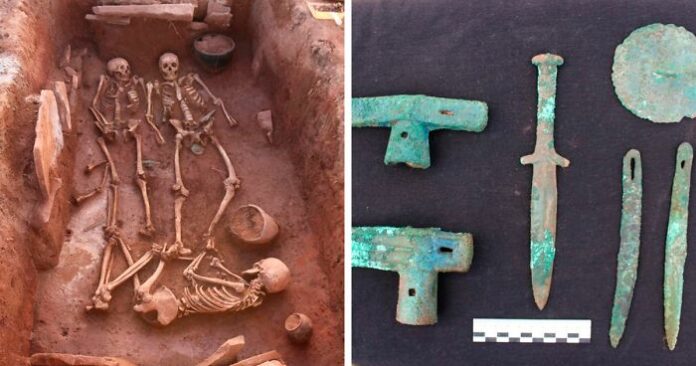Archaeologists in Siberia have made an extraordinary discovery – a 2,500-year-old grave containing the remains of an ancient warrior couple, along with a newborn and an elderly servant woman. This remarkable find is shedding new light on the lost Scythian civilization that once thrived in the region.

Burial Discoveries
The grave, believed to belong to a warrior couple who died in their 30s, was unearthed by the research team. Interred alongside the couple were the remains of a newborn and an elderly woman, likely a servant who passed away in her 60s. The baby’s remains were scattered throughout the grave, most likely due to rodent activity after burial.
Significance for Understanding the Scythian Civilization
This remarkable discovery sheds new light on the Scythian civilization, which existed in the region of modern-day Russia until approximately 2,200 years ago. The Scythians were known to have had a strong warrior culture, with young female warriors as well as male. Ancient Greek historians, such as Herodotus, have left records of these fierce female fighters, but the new grave offers a unique opportunity to further explore this aspect of Scythian society.
Unique Burial Practices and Grave Goods
The most unusual aspect of this discovery is the burial of the warrior woman alongside her male counterpart, both interred with an impressive array of weaponry. While female Scythian warriors were typically buried with long-range weapons like bows and arrows, the woman in this grave was laid to rest with a long-handled weapon, potentially an axe or hatchet, as well as a short sword. The male warrior was buried with two axes, two bronze daggers, and a bronze mirror, providing researchers with an “authentic bronze weaponry” set.

The grave also contained larger ceramic vessels filled with mutton and beef, a common practice in this time period, as it was believed these goods would aid the deceased in the afterlife.
Potential Cause of Death
Surprisingly, the researchers found no evidence of battle wounds on the remains of the four individuals. This has led them to believe that the four people may have died simultaneously from the same infection. The presence of the elderly servant woman buried alongside the family has led researchers to speculate that she may have been interred to attend to the couple and the newborn in the afterlife.

Insights into Gender Roles and Warrior Culture
The discovery of the warrior woman buried with close-combat weapons, rather than the typical long-range weapons, challenges the notion that female Scythian warriors were limited to specific types of armaments. This suggests that both men and women actively participated in warfare, and that violence was an accepted and legal means of problem-solving at the time.

Overall, this remarkable 2,500-year-old grave has provided archaeologists with a unique window into the lost Scythian civilization, offering insights into their burial practices, gender roles, and warrior culture that were previously unknown.
